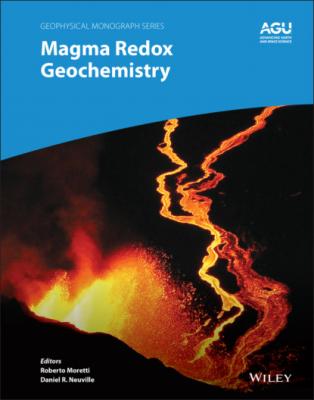Magma Redox Geochemistry. Группа авторов
Читать онлайн.| Название | Magma Redox Geochemistry |
|---|---|
| Автор произведения | Группа авторов |
| Жанр | Физика |
| Серия | |
| Издательство | Физика |
| Год выпуска | 0 |
| isbn | 9781119473244 |
(1.49)
(1.50)
(1.51)
All these equilibria have the interesting feature of displaying unitary activities for oxide component appearing as pure phases, such that their equilibrium constants simply describe the variations of O2 activity (aO2) with temperature:
(1.52)
or, by defining fugacity, with temperature and pressure:
(1.53)
with A, B, and C constants. The pressure term, C, allows computing directly fO2 rather than aO2 at the pressure of interest. Mineral assemblages making up Reactions 1.1 and 1.44 to 1.47 are not necessarily occurring in deep Earth and igneous environments, whereas the actual multi‐component space of phases fix the aO2 via multiple equilibria in which solid solutions and/or the presence of relatively mobile liquid (silicate melts) and/or supercritical fluids play a fundamental role.
Figure 1.6 Common solid oxygen buffers used in petrology and geochemistry. The lines represent the fugacity‐temperature conditions where the phases coexist stably. FMQ: fayalite, magnetite, quartz; IW: iron–wüstite; WM: wüstite–magnetite; HM magnetite–hematite. Oxygen fugacity values were computed for a total pressure of 1 bar. Also reported is the value of logfO2 in air (PO2 ~0.21 bar).
However, when one of these mineral “buffers” is selected as a reference, the acting logfO2 can be given as a relative value, without temperature:
A relative fO2 scale embodying temperature effects bears just a practical implication (tracking fO2 variations with respect to a reference) but not a real meaning about logfO2 evolution in igneous systems and related environments (e.g., Moretti and Steffansson, 2020). In particular, a common misconception was that in a system a given value of Δbuffer (e.g., ΔQFM = 0.5) could represent some kind of “magic number” characteristic of the whole “rock system” throughout its thermal and chemical evolution. In natural environments oxygen activity (hence fugacity) in fact varies to accommodate the compositional variations and the speciation state of the mineral/melt/fluid phases, and also when highly mobile volatile components are involved, such that fO2 can thus be fixed by factors that are external to the system object of the thermodynamic description.
Similarly, the rock system evolution cannot be approximated by a unique FeII/FeIII ratio, that the system had when completely molten. Indeed, two rocks that have ideally crystallized along the QFM buffer may have different proportions of fayalite ad magnetite because of the crystallization style but different FeII/FeIII bulk ratios (Frost, 1991). However, in some systems, it is possible that the melt fixed the redox potential of the system via iron oxidation state, with the FeII/FeIII ratio approaching unity (e.g. Moretti et al., 2013).
It is also important to recall that fO2 is just a thermodynamic parameter used to conveniently report the oxidation state of a system, particularly when O2 is not an existing gaseous species that could be detected if the system were accessible to measurements. This is clearly proved by the very low values reported in ordinates in Figure 1.6. Therefore, fO2 turns out to be by‐product of thermodynamic calculations applied to the analyses from natural samples, in which the true redox observables are the oxidation states of iron and other elements in minerals and liquids. The common practice is then to measure the concentration ratio of redox couples of multiple valence elements in melts (FeII/FeIII, but also S‐II/SVI, VIII/VV, etc.) or in gases (e.g., H2/H2O, CO/CO2, H2S/SO2) and relate them to fO2 via thermodynamic calculations using appropriate standard state thermochemical data. As fO2 is provided, its value is then anchored via Equation 1.54 to a given gas‐solid buffer of the Reaction type 1.1 or 1.48 to 1.51. This is quite easy for gases, in which governing equilibria are directly solved if the gas analysis is provided (e.g., Giggenbach, 1980, 1987; Aiuppa et al., 2011 and references therein) and also for solid–solid equilibria, such as in case of coexisting iron–titanium oxide solid solutions titanomagnetite (Fe3O4‐Fe2TiO4) and hemo‐ilmenite (Fe2O3–FeTiO3) (Buddington and Lindsley, 1964) or for peridotite assemblages in the mantle (e.g., Mattioli and Wood, 1988; Gudmundsson and Wood, 1995), in which the good thermodynamic characterization of solid solutions allows quite accurately treating component activities, based on mineral analyses.
On the contrary, it is much less straightforward for fO2 estimates by oxidation states of Fe and/or S measured in glasses, as the oxybarometers derived by the study of synthetic quenched melts still suffer from too many empiric approaches. Because of their polymerized nature, silicate melts do not allow a precise distinction between solute and solvent like in aqueous solutions, where complexes and solvation shells can be easily defined in which covalence forces exhaust (see also Moretti et al., 2014). In fact, melt composition largely affects the ligand constitution and then the speciation state of redox‐sensitive elements. In the case of the FeII/FeIII ratio, the most common redox indicator for melts/glasses, the choice of components in reaction:
over a large compositional range (e.g., from mafic to silicic) does not offer the possibility to find accurate and internally consistent expressions for the activity coefficients of oxide components γFeO and γFeO1.5 (with FeO1.5 conveniently replacing Fe2O3) that solve the reaction equilibrium constant:
in which the term within integral is the difference of partial molar volumes of iron components. Expansion of excess contribution to its Gibbs free energy of mixing is used to define γFeO and γFeO1.5 in melt mixtures. However, when these are adopted to solve Equation 1.56 for measured FeII/FeIII values, they show success only over limited compositional datasets (Moretti, 2020 and references therein).
